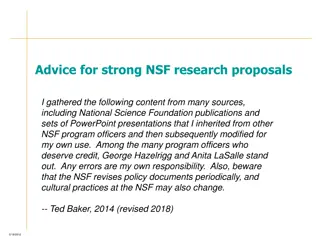Ongoing Collaborations in Scientific Domains for NSF Review Preparedness
Ongoing and future collaborations between the High-Performance Algorithm-System-Hardware Co-Design (HAC) team with Machine Learning and Analytics (MMA) and Neuroscience areas are outlined. Collaborations include merging Pylog and HLS4ML into IceCube experiments, utilizing SPVCNN and GNN for neutrino reconstruction and muon direction estimation, and establishing partnerships with NeuroS. Teams at MIT and GT are achieving significant advancements in efficient point cloud processing and scalable geometric deep learning. Plans for the next months include conference submissions and further research developments in these interdisciplinary collaborations.
Download Presentation

Please find below an Image/Link to download the presentation.
The content on the website is provided AS IS for your information and personal use only. It may not be sold, licensed, or shared on other websites without obtaining consent from the author. Download presentation by click this link. If you encounter any issues during the download, it is possible that the publisher has removed the file from their server.
E N D
Presentation Transcript
HAC coordination with ALL scientific domains Identify ongoing/future collaborations between HAC with MMA and NeuroS Goal: Being prepared for NSF review in July; Long-term health of the A3D3 ecosystem HAC - MMA: Pylog (Tim, Deming) + HLS4ML (Vladimir, Phil) are to be further merged into IceCube experiments (Benedikt and others); Other option I: SPVCNN (Song, Phil, Shih-Chieh) for Neutrino Reconstruction Other option II: GNN (Pan) for low-energy muon direction estimation in IceCube (Prof. Ignacio Taboada, GT) HAC Neuroscience: Scott and his students will represent HAC direction (partially targeted system) as an established collaboration with Neuroscience. 1
Algorithm-System-Hardware Co-Design for Efficient Point Cloud Processing Team at MIT: Zhijian Liu, Haotian Tang, Yujun Lin, Song Han Achievements in the past month: Improved the performance of TorchSparse++: Achieved 2.9X speedup over MinkowskiEngine (from NVIDIA). Achieved 3.3X and 1.8X speedups over SpConv v1/v2 (from TuSimple). Improved the performance of BEVFusion-R: Achieved 2X speedup over the state-of-the-art CRN. Goal for the next month: Prepare the submission of TorchSparse++ for MICRO 2023. Prepare the submission of BEVFusion-R for CVPR 2023 VCAD Workshop. 2
Interpretable & Scalable Geometric Deep Learning Team at GT&Purdue: Siqi Miao, Haoteng Yin, Jiajun Zhu, Mia Liu, Pan Li Achievements in April: Scalable geometric deep learning (GDL) For the HEP tracking task Kernelized physics constraints and edge features into low-rank transformers Performs comparable to GNN SOTA (0.3% off in AUC), w/ extremely low complexity Interpretable GDL models models Benchmarked 4 baselines on 2 HEP datasets Found empirical gaps between model sensitivity and trustworthiness Plans in May: Study more advanced kernels and benchmark pileup mitigation tasks Test how different randomness in interpretable methods would impact final results 3
Domain Adaptation on Graph Machine Learning & OOD Team at GT&Purdue: Shikun Liu, Tianchun Li, Yongbin Feng (Fermi), Nhan Tran (Fermi), Han Zhao (UIUC), Qiang Qiu, Pan Li OOD team: Deyu Zou, Siqi Miao, Shikun Liu, Pan Li, Shiyu Chang (UCSB) Achievements in April: StruRW project Get accepted to ICML 2023 Revise the analysis part and experimental part for the final arxiv/camera-ready version OOD project Explore the recent geometric backbone used in the project Finalize the general baseline for shifts in all datasets, explore the detailed and specific baseline for each type of shift (material science fidelity shift) Plan in May: Publish the arxiv version and submit the camera-ready version of the StruRW paper Read related papers and brainstorm for the follow-up graph DA project Plan to explore the detector shift in the HEP datasets and more possible scenarios in material science datasets 4























